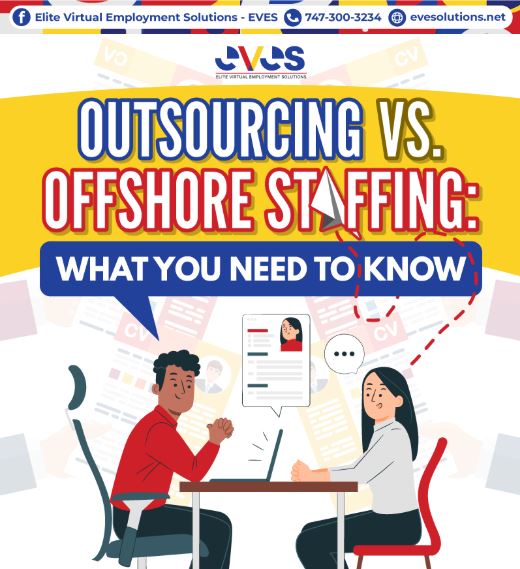Getting work done, and managing the professionals doing that work, has evolved from strictly in-house teams to various global talent-sourcing models. In fact, outsourcing and offshore staffing have gone mainstream for many iconic American corporations as evidenced by offshore success stories like Google, Dell, Accenture, and JPMorgan Chase Co.
Despite the success of outsourcing and offshore staffing for these leading companies though, some businesspeople still don’t clearly understand the differences between the two models.
Understanding Outsourcing vs. Offshore Staffing
Outsourcing
Outsourcing is the practice of contracting specific business functions or processes to third-party providers, rather than handling them in-house.
In outsourcing, the talents working on the projects or tasks are not the company’s employees. Instead, the workers have a separate contract with the outsourcing company. This strategy relieves the organization from the responsibility of recruiting and managing functional teams. Outsourcing lets companies focus on core competencies while leveraging the specialized expertise and efficiencies of external vendors for non-core activities.
Key Benefits of Outsourcing
- Less overhead expenses.
- Reinvigorated focus on core functions.
- Access to specialized domestic and international talent.
Offshore Staffing
Offshore staffing is the business practice of relocating specific business processes or operations to a foreign country. In offshoring, tasks are transferred to regions where operational expenses and labor are significantly lower than in the home country. This model fosters integration and collaboration of the offshore team with the in-house staff so businesses can scale their workforce efficiently while leveraging global talent pools.
What makes offshore staffing unique is its focus on leveraging geographic advantages, like lower labor costs and greatly reduced overhead. It differs from outsourcing because it emphasizes the international aspect of relocating work to overseas staff. While companies must adapt to cultural differences and foreign regulations, it can enhance their ability to scale operations quickly and tap into diverse talent pools.
Key Benefits of Offshore Staffing
- Greatly reduced labor costs.
- Direct management of offshore staff.
- Recruitment headaches transferred to offshore staffing agencies.
Deciding Between Outsourcing and Offshore Staffing
While both outsourcing and offshore staffing present favorable advantages for companies, business leaders need to identify which is more appropriate for their organization.
Here are the key factors to consider when deciding between the two models.
1. Long-Term vs. Short-Term Goals
A company’s strategic objectives drive its decision-making.
- Offshoring allows long-term growth because it builds a committed workforce.
- Outsourcing offers flexibility and scalability for short-term projects or seasonal demands.
2. Control and Management
After defining the company’s goals, identify the level of control the company wishes to maintain over operations.
- Offshoring enables companies to manage their team directly.
- Outsourcing involves less direct control as the third-party provider manages the team.
3. Nature of Tasks
Routine or complicated?
- Outsourced staff are best suited for standardized tasks which don’t require close collaboration with in-house teams.
- Offshore staffing is ideal for complex tasks requiring tight coordination with in-house teams.
4. Data Sensitivity
Having identified the tasks, assess the sensitivity of the information involved to avoid any confidentiality hazards.
- Better data security is observed in offshore staffing due to employee integration.
- Security measures for handling sensitive data must be incorporated into the service level agreement with outsourcing
5. Cost Considerations
Both outsourcing and offshore staffing can lead to significant cost savings, but they do so in different ways.
- Offshore staffing typically offers long-term savings thanks to lower wages in the host country.
- Outsourcing provides immediate savings on operational expenses but may involve variable costs based on project scope or service level agreements.
6. Cultural Alignment
Employees with similar or related cultures usually collaborate more effectively.
- Offshore staff members can often be integrated into the firm’s culture, resulting in better teamwork.
- The outsourcing provider may or may not adapt to your organizational culture.
7. Communication Dynamics
Good workplace communication is essential to high-performing teams, so it’s important to understand how the two models differ.
- Offshore staffing typically entails real-time, direct communication with remote employees.
- Outsourcing may often involve indirect communication channels with external teams.
Other Talent Sourcing Models
Lesser known alternatives to outsourcing and offshoring.
● Nearshoring
Nearshoring is the practice of relocating certain business processes to a nearby country. By doing so, businesses can maintain closer oversight of operations.
Key Benefits of Nearshoring
- Closer geographic proximity.
- Minimized communication barriers due to shared or similar cultures.
- Similar time zones minimize off-hours interactions.
Nearshoring may not yield the same level of cost savings as offshoring since labor costs in neighboring countries might still be higher than those in more distant locations.
● Staff Leasing
For companies seeking flexibility while still retaining control and keeping workers local, staff leasing could be an option. Staff leasing allows businesses to scale their workforce up or down based on project needs without the long-term commitment associated with traditional hiring.
Key Benefits of Staff Leasing
- Relieved administrative burden due to management of professional employer organization (PEO).
- Access to pre-recruited workers.
- Scalability based on project needs.
The downside of staff leasing, however, is that it may lead to less control over employee management practices since the leasing company retains responsibility for certain HR functions.
● Subcontracting
Subcontracting involves hiring a third party, either an individual or an organization, to perform specific tasks or projects within a larger contract.
Key Benefits of Subcontracting
- Shared risks associated with project delivery.
- Flexibility without hiring new, permanent employees.
- Defined scope and terms with formal contractors.
Subcontracting may lead to coordination and quality challenges in project management. Unlike offshore staffing, managing communication with multiple contractors can be difficult. Quality may also vary based on each subcontractor’s expertise.
Start Offshore Outsourcing from the Philippines with EVES
Ultimately, the company’s goals must be prioritized when choosing to offshore certain functions. With offshore outsourcing, businesses can balance the advantages of both offshore staffing and outsourcing, leveraging the skills of an international third-party firm while maintaining the strategic direction of operations.
Partner with Elite Virtual Employment Solutions (EVES) today and experience the benefits of offshore outsourcing with a dedicated and competitive team in the Philippines.
Contact us at info@evesolutions.net to equip your team with the help it needs.








Leave A Comment
You must be logged in to post a comment.